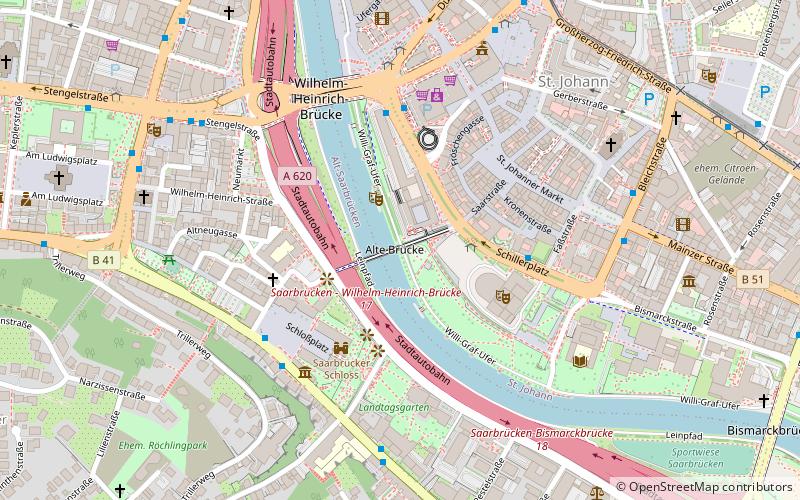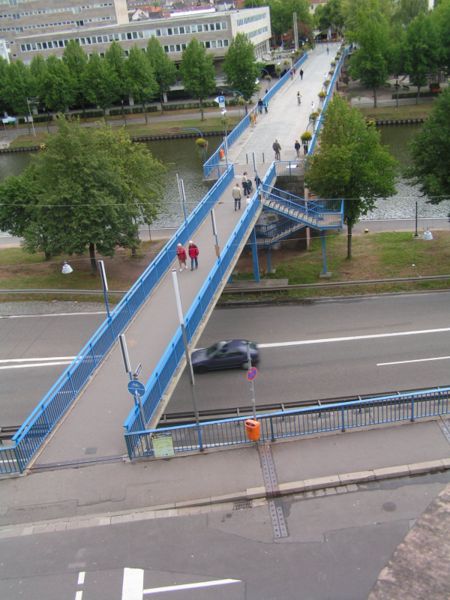Alte Brücke, Saarbrücken


Facts and practical information
The Old Bridge over the Saar in Saarbrücken is the oldest preserved bridge in Saarland. It connects the districts of St. Johann and Alt-Saarbrücken and is open only for pedestrians and bicycle traffic.
The bridge is located in the immediate vicinity of the State Theater, St. Johanner Markt and Saarbrücken Castle.
It was built in 1546/49 under Count Philipp II after Emperor Charles V was unable to cross the river at this point for several days due to high water. After the Roman bridge a little further upstream, which fell into disrepair in the early Middle Ages, the Old Bridge was the first Saar bridge in centuries. It was destroyed and rebuilt at least twice.
In 1904, two of the central bridge piers were elaborately extended to make room for an equestrian statue of Emperor Wilhelm I, which was inaugurated on May 14, 1904 in the presence of Emperor Wilhelm II and Empress Auguste Viktoria. The Kaiser Wilhelm Monument had been designed by the sculptor and Rietschel student Adolf von Donndorf, who came from Weimar, based on the model of the monument at Hohensyburg Castle. Donndorf had received the commission through a good acquaintance with the mayor of Saarbrücken, Friedrich Wilhelm Feldmann. The monument, which cost over 137,900 marks to build, survived the partial blowing up of the bridge by fleeing German troops in 1945 and was taken down after the end of World War II on the orders of the French occupying power as a symbol of Prussian militarism. The positioning of the Emperor's monument on the bridge was modeled on the equestrian monument of Henry IV on the Pont Neuf over the Seine in Paris and the equestrian statue of the Great Elector on the former Long Bridge over the Spree near the Berlin Palace.
On the St. Johann side of the bridge, several of the original 14 arches were lost or filled in due to the construction of the Ministry of Finance and the creation of the square now called Tifliser. On the Old Saarbrücken side, too, one arch was lost in the course of a Saar straightening around the year 1763. Conversely, during the construction of the city highway from 1961 to 1963, the bridge on the Alt-Saarbrück side was extended with a steel footbridge, which bridges the highway at Leinpfad level. The castle wall built by Friedrich Joachim Stengel and bordering the castle rock was moved back 17 meters on this occasion and the directly adjacent historic Oberamtshaus, also built by Stengel, was demolished to make room for Franz-Josef Röder-Strasse, which also serves as a flood bypass for the city highway and to which the Old Bridge is connected on its southwest side. In the course of the canalization of the Saar River, which was decided in 1973, the Old Bridge was almost demolished because the clearance heights and widths of the bridge arches were not sufficient for European ships. However, it was decided not to extend the Saar expansion to the eastern port of Saarbrücken as originally planned.
In 2021, plans became known to comprehensively rehabilitate the Old Bridge, replacing the steel extension footbridge with a new structure.
The bridge is depicted on a definitive stamp from 1922, the stamps for "Stamp Day" in 1951 and on a special stamp from 1973.
Mitte (St. Johan)Saarbrücken
Alte Brücke – popular in the area (distance from the attraction)
Nearby attractions include: Ludwigskirche, Saarbrücken Castle, Ludwigsparkstadion, Europa-Gallerie.
Frequently Asked Questions (FAQ)
Which popular attractions are close to Alte Brücke?
How to get to Alte Brücke by public transport?
Bus
- Staatstheater • Lines: 109, 126, 128, 150, 506, 666, R10 (3 min walk)
- Karstadt • Lines: 126, 128, 506, 666, R10 (4 min walk)
Tram
- Johanneskirche (8 min walk)
- Landwehrplatz (9 min walk)
Train
- Saarbrücken Central Station (18 min walk)
- Saarbrücken Ost (29 min walk)











